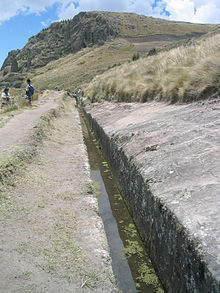This article needs additional citations for verification .(March 2015) |
 Partial view of aqueduct at Cumbemayo. | |
| Alternative name | Cumbe Mayo |
|---|---|
| Location | Cajamarca Province, Cajamarca |
| Coordinates | 07°11′23″S78°34′26″W / 7.18972°S 78.57389°W |
| Type | Aqueduct, Temple, Petroglyphs |
| History | |
| Builder | Cajamarca culture |
| Founded | 1500 BCE |
| Site notes | |
| Archaeologists | Julio C. Tello |
Cumbemayo or Cumbe Mayo is an archaeological site located 20 kilometers southwest of the city of Cajamarca in Peru at 3,500 meters of elevation. [1] Built around 1500 B.C.E, it comprises aqueducts, a grotto and petroglyphs; all within an area of rock formations. [1]


